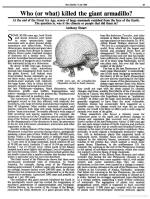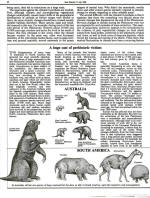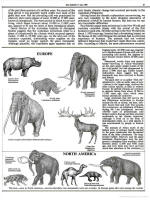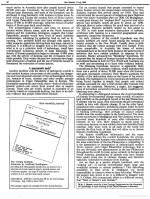|

by Robert Bast
2009
from
Survive2012 Website
Spanish version
Poleshifts
Quote #1
These repeated irruptions and
retreats of the sea have neither been slow nor gradual; most of
the catastrophes which have occasioned them have been sudden;
and this is easily proved, especially with regard to the last of
them, the traces of which are the most conspicuous.
In the
northern regions it has left the carcasses of some large
quadrupeds which the ice has arrested, and which are preserved
even to the present day with their skin, their hair, and their
flesh. If they had not been frozen as soon as killed they must
quickly have been decomposed by putrefaction.
But this eternal frost could not
have taken possession of the regions which these animals
inhabited except by the same cause that destroyed them; this
cause, therefore, must have been as sudden as its effect.
The breaking to pieces and overturnings of the strata, which
happened in former catastrophes, shew [sic] plainly enough that
they were sudden and violent like the last; and the heaps of
debris and rounded pebbles which are found in various places
among the solid strata, demonstrate the vast force of the
motions excited in the mass of waters by these overturnings.
Life, therefore, has been often disturbed on this earth by
terrible events - calamities which, at their commencement, have perhaps moved and overturned to a great depth the entire
outside crust of the globe, but which, since these first
commotions, have uniformly acted at a less depth and less
generally.
Georges Cuvier (1769-1832)
"Revolutions
and Catastrophes in the History of the Earth"
[1]
Quote #2
"The fact of the bones occurring in
great caches or deposits in which various species are mixed
pell-mell is very important, and it is a fact undenied by
geologists that whenever we find such a locality in which
animals have suffered together in a violent and instantaneous
destruction, the bones are invariably mixed and, as it were,
'deposited' in a manner which could hardly be explained
otherwise than by postulating the action of great tidal waves
carrying fishes and all before them, depositing them far inland
with no respect to order."
Howorth, Sir Henry
The Mammoth
and the Flood: Uniformity and Geology, London, 1887, p.180.
Opposing Views
Not everyone aggress on the processes
at work upon our planet.
The new theory of uniformitarianism
currently prevails, but the ancient concept of catastrophism is
still alive and kicking.
-
Uniformitarianism/Gradualism:
A theory that says the natural processes that change the Earth
in the present have operated in the past at the same gradual
rate, and that geological formations and structures can be
interpreted by observing present-day actions.
-
Catastrophism: A theory that
says the geological features of the Earth were formed by a
series of sudden, violent catastrophes rather than a gradual
evolutionary process.
Since the 1830s
conventional geological theory has revolved around the concept of
uniformitarianism (or gradualism) - that the processes of the
Earth have always been the same as we can observe today.
The
originator of these ideas was Scottish geologist James Hutton
(1726-1797), although it took the efforts of Charles Lyell
(1797-1875) and his Principles of Geology (1830) to enable
the theory to become widespread. This new gradualist viewpoint,
involving time-spans of millions of years, gave rise to the modern
ideas of continental drift, the ice ages and Charles Darwin's theory
of evolution.
Gradualism is obvious with any visit to
a beach or canyon - the actions of nature changing the face of the
planet.
Waves gently move grains of sand about, and rivers slowly
but surely carve great gashes into the earth. Although gradualism
is forced to permit small-scale catastrophes such as volcanoes and
hurricanes that we can easily witness, larger activities such as
continental drift, the formation of mountains, and ice ages are
judged to be non-catastrophic, and must happen gradually over
many millions of years.
The strength of the uniformitarian
convictions can be seen in the words of James Hutton:
As it was in the beginning, is now, and
ever shall be, world without end.
Not only are no powers to be
employed that are not natural to the globe, no action to be admitted
of except those of which we know the principle, and no extraordinary
events to be alleged in order to explain a common appearance, the
powers of nature are not to be employed in order to destroy the very
object of those powers. Chaos and confusion are not to be introduced
into the order of nature, because certain things appear to our
partial views as being in some disorder.
Nor are we to
proceed in feigning causes when those seem insufficient which occur
in our experience.[2]
In my opinion, this is as preposterous
as a child who closes his eyes, and declares that what he cannot
see, cannot exist!
Popular for the millennia prior to the
1830s, is the more obvious idea of catastrophism. Unfortunately it
has been discounted by modern scientific techniques, which require
processes to be recreated in a laboratory, or at least viewed in
nature within a recent timeframe. The art of making educated guesses
based on the physical remnants of ancient disasters is no longer
acceptable.
Even Charles Darwin, a staunch
uniformitarian, upon his visit to South America, noted how global
catastrophes appear to have occurred previously..
"The greater number, if not all, of
these extinct quadrupeds lived at a late period, and were
contemporaries of most of the existing sea-shells. Since they
lived, no very great change in the form of the land can have
taken place.
What then, has exterminated so many species and
whole genera?
The mind at first is irresistibly hurried into the
belief of some great catastrophe; but thus to destroy animals,
both large and small, in Southern Patagonia, in Brazil, on the
Cordillera of Peru, in North America up to Behring's Straits, we must shake the entire framework of the globe."
[3]
In the 1800s, when scientists changed
allegiance from the old theory to the new, an important
consideration was neglected - that extraterrestrial agencies could
affect changes upon the Earth.
Interaction between our planet and
the heavens was unheard of. A classic example comes from one of the
early American presidents, Thomas Jefferson, in 1807.
When told
that two Yale scientists were claiming that meteorites had recently
struck the ground at Weston, Connecticut, he replied:
"It is easier to believe that two
Yankee Professors would lie, than that stones would fall from
heaven."
Similarly, the meteor crater of
Arizona, with a width of 1.2 kilometers, was only determined to be
created by a meteor in the last century.
In the 1800s, it was
considered to be a volcanic remnant. It is apparent that the new
theory of gradualism was formed without consideration of
extraterrestrial agencies, and may never have developed at all if
meteors and supernovas had been taken into consideration.
The hypothesis of Luis Alvarez and
colleagues, that a large asteroid wiped out the dinosaurs, has
recently been accepted by academia. This is obviously catastrophism,
yet it survives the tests of uniformitarianism due to two facets: it
is a brand new idea (untainted by previous arguments), and we can
observe asteroids on a regular basis.
Old ideas, previously rejected, are
very rarely, if ever, successfully brought back to life.
Yet in
recent times the Catastrophists have staged a comeback, due
in part to the works of
Immanuel Velikovsky, author of three
controversial science books in the 1950s.
References
[1] Sourced from
A Source Book in Geology, ed. K.
Mather (New York and London: Hafner Pub. Co. 1964)
[2] James Hutton, as quoted in J. Bowles'
The Gods,
Gemini and the Great Pyramid, from Theory of the Earth
(1788)
[3] Charles Darwin,
The Voyage of the Beagle,
entry dated Jan 9 1834, p178.
Immanuel Velikovsky
(1895-1979)
Velikovsky was born in Vitebsk, Russia.
As a child he learned several languages, and excelled in
mathematics. In 1913 he travelled to Europe, visiting Palestine,
briefly studying medicine at Montpelier, France, and taking
premedical courses at the University of Edinburgh.
Just before the outbreak of World War
I, Velikovsky returned to his homeland and enrolled in the
University of Moscow, where he received a medical degree in 1921.
From there he went to Berlin, where he married a young violinist and
became the general editor of the journal, Scripta Universitatis.
During this time he became acquainted with Albert Einstein, who
edited the journal's mathematical-physical section. Velikovsky
shifted to Palestine in 1924 and practiced psychoanalysis for the
next 15 years. Some of his writings appeared in Freud's Imago.
In 1940, Velikovsky studied a number of
natural disasters that occur in the Bible, such as the parting of
the Red Sea and the eruption of Mt. Sinai. When he compared these
biblical passages to similar entries in some obscure Egyptian texts,
he became convinced they were describing the same catastrophes, and
went about reconstructing ancient Middle Eastern time-lines to make
both sides fit.
After studying other historical
records, he became convinced that many catastrophes were linked to a
single global cataclysm, and that Venus was involved. In 1939 he
shifted to the United States and for the next ten years he
researched these topics, the result being two separate books:
Ages in Chaos - a historical reconstruction covering the years
1450 BC to 840 B.C, and
Worlds In Collision.
In 1950 Macmillan published Worlds
in Collision. It described how 3,500 years ago Venus was ejected
from Jupiter as a comet - then started a wayward path through the
solar system. Its gravitational field moved other planets out of
their orbits or affected their rotation - including Earth's.
Macmillan, who publish many textbooks, came under fire from
scientists and academics who considered Velikovsky's ideas to be
unacceptable - ideas at odds with uniformitarianism.
The book was
consequently banned from many academic institutions. Although it was
at the top of the New York Times non-fiction bestseller list,
Macmillan gave in and transferred the book to Doubleday. In 1952
Doubleday pub1ished Velikovsky's Ages in Chaos.
As an answer to his
critics, Velikovsky's third book,
Earth In Upheaval
(1955),
presented raw data that would validate any global cataclysm theory:
"I have excluded from [these pages]
all references to ancient literature, traditions, and folklore;
and this I have done with intent, so that careless critics
cannot decry the entire work as "tales and legends". Stones and
bones are the only witness."[4]
It was fully
referenced and designed to gain the support of orthodox science -
however academia had already determined that anything he ever wrote
would automatically be unacceptable.
Meanwhile Velikovsky had been
maintaining contact with Einstein - he would send him letters and
manuscripts and Einstein would return them, usually with comments
written in the margins. With regards to Earth in Upheaval,
Einstein accepted all the evidence of sudden violence upon the
Earth, but he rejected Venus as being the cause.
Nine days after
their final meeting Einstein died, and a copy of Worlds in
Collision was found open on his desk. He was rereading it
because latest discoveries concerning Jupiter had confirmed one of
Velikovsky's predictions.
It is currently accepted that a comet
wiped out the dinosaurs, yet in the 1950s, when Velikovsky suggested
similar ideas, he was rejected.
In fact many of his radical ideas
that orthodox science originally laughed at, due to their lack of
scientific foundation, have become proven facts:
-
Jupiter
periodically becomes unstable and ejects excess mass.
-
Jupiter emits non-thermal radio
noise.
-
Comets can
be rich in hydrocarbons, with highly energetic electrical tails.
-
The Moon has
had recent surface melting, seismic and volcanic activity, none
of which should be true for a body that had supposedly been dead
for 4.5 billion years.
Velikovsky deduced each of these facts
many years before mainstream science found ways to prove them.
He
also stated that after its close encounters with Earth, Mars and the
Sun, Venus would have a much higher than expected temperature, would
be enveloped in hydrocarbon clouds (remnants of its comet's tail),
and would have an anomalous rotation.
The scientists' predictions -
a similar temperature to Earth, an atmosphere of carbon dioxide or
water and standard rotation - have all since been shown to be wrong.
Venus has a surface temperature of 750 degrees Kelvin - hot enough
to melt lead. Its atmosphere is full of hydrocarbons and its
rotation is in an opposite direction to all the other planets.
With hindsight, academia should be
re-examining his work, for more of his startling ideas could also be
correct.
Here is Velikovsky's hypothesis on what may have previously
happened to our planet:
"...that under the impact of a force
or the influence of an agent - and the earth does not travel in
an empty universe - the axis of the earth shifted or tilted.
At
that moment an earthquake would make the globe shudder. Air and
water would continue to move through inertia; hurricanes would
sweep the earth and the seas would rush over continents,
carrying gravel and sand and marine animals, and casting them on
the land. Heat would be developed, rocks would melt, volcanoes
would erupt, and lava would flow from fissures in the ruptured
ground and cover vast areas.
Mountains would spring up from the
plains and would travel and climb on the shoulders of other
mountains, causing faults and rifts. Lakes would be tilted and
emptied, rivers would change their beds; large land areas with
all their inhabitants would slip under the sea.
Forests would
burn, and the hurricanes and wild seas would wrest them from the
ground on which they grew and pile them, branch and root, in
huge heaps."
"Water evaporated from the oceans would
rise in clouds and fall again in torrential rains and snowfalls.
Clouds of dust, ejected by numerous volcanoes and swept by
hurricanes from the ground. All this dust would keep the rays of the
sun from penetrating to the earth." [5]
Perhaps the extra-terrestrial agent was
a force such as an electromagnetic field?
The Earth is a giant
magnet, and the fields would act upon each other. Duration would not
be a factor - if the strength of this field were strong enough to
tip the earth over, it would happen instantly, triggering the
effects Velikovsky listed above.
References
[4] Immanuel Velikovsky,
Earth in Upheaval (1955),
preface.
[5] Immanuel Velikovsky,
Earth in Upheaval (1955),
p.120-121
Rather than the Earth being a solid
piece of rock, it is divided into distinct layers. We live on the
outer surface of the crust, which is broken up into six main
continental plates and a few smaller ones.
Geologists have
differing opinions on what is further below, but for our purposes
this simplified model will suffice:
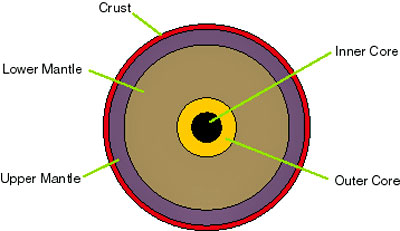
The inner core consists of solid iron
and is surrounded by an outer core of liquid iron.
The lower mantle
is made of molten rock. The upper mantle and crust are solid, but
only loosely connected and are able to slip and slide against each
other, the least effect of which is continental drift. All layers
are capable of independent movement.
Directly below the Earth's crust (or
lithosphere) at a depth of 50-150 kilometers is a layer called the
asthenosphere. It is constructed of a low-velocity plastic material
capable of flow. The crust is split into plates, and the tectonic
plate theory says that these plates move individually, slipping over
the hot semi-plastic asthenosphere, at a rate of 1-4 cms. a year.
The action of these plates pushing against each other causes
mountain ranges to form, causes earthquakes and stimulates volcanic
activity.
Apart from being a permanent constant
(orthodox gradualist view), this movement of a miniscule 1-4 cms. a
year could also be the low point in a fluctuating system, or the
crust's momentum finally coming to a halt after a major slippage of
30 degrees, which occurred in recent times - perhaps 12,000 years
ago.
There are two ways in which the
location of the poles might shift:
1. Poleshift: A sudden and
radical displacement of the planet's axis of rotation (the earth
tips over).
-or-
2. Poleshift: A slippage of
the planet's solid crust over the molten interior - so that the
polar locations change.[6]
Entire planet tipping over
The layers of the Earth remain stable,
and the entire planet tips over as one unit.
This could either be
caused by unknown extra-terrestrial forces, or the Earth somehow
becoming unbalanced. A similar unbalancing event probably happened
on Mars. Along its equator is a massive volcano known as Tharsis,
which is the largest known gravity anomaly in our solar system. Either this volcano formed on the equator and has remained there
ever since, or, more likely, it formed elsewhere and then migrated
there due to centrifugal forces.
If a point on a spinning globe is
much heavier than average, then centrifugal forces will try to shift
that point towards the equator.
If this happened to Earth then it is
hard to say how fast it would shift, or what level of catastrophe
would occur. It could feasibly be so slow and uneventful that we
wouldn't even notice.
In 1955 Thomas Gold
[7] stated that if the earth were a perfect sphere instead
of a flattened spheroid,
'the smallest beetle walking over it would
be able to change the axis of rotation relative to markings on the
sphere by an arbitrarily large angle; the axis of rotation in space
would change by a small angle only'.
Fortunately, that cannot happen,
because the earth has an equatorial bulge.
This gives our planet
stability, in the same way that a spinning top, which is wider in
the middle, manages to stay upright as long as it keeps spinning.
Made out of solid wood, a top could
happily spin forever without any harm coming to it. But if it were
hollow, however, and something loose was rattling around inside,
then its spinning actions would eventually cause it to wear our -
friction and interaction between two objects will always eventually
cause fatigue and destruction. The earth, as we saw above, is not a
single solid unit - it has layers that scrape against each other.
Slippage of the crust
Charles Hapgood proposed that this
slippage between the top two layers of the Earth allows for the
continental plates to move as a single unit, rapidly over great
distances - just as the skin of an orange, if separated from the
fruit's inner part, can move as one piece.
The core remains where
it is, and the axis and orbit of the planet remain unchanged. Orthodox science, fixating on the idea of gradualism, has chosen to
ignore this idea.
They have yet to disprove it.
The crust's movement over the
asthenosphere would create mayhem. If the current level of volcanic
and earthquake activity is caused by plates shifting 1-4 cms a year,
then imagine what would happen if they shifted thousands of
kilometers in less time!
In 1955,
just prior to his death, Albert Einstein wrote this foreword to a
book on pole shifts:
I frequently receive communications
from people who wish to consult me concerning their unpublished
ideas. It goes without saying that these ideas are very seldom
possessed of scientific validity.
The very first communication,
however, that I received from Mr. Hapgood electrified me. His
idea is original, of great simplicity, and - if it continues to
prove itself - of great importance to everything that is related
to the history of the earth's surface.
The author has not
confined himself to a simple presentation of the idea. He has
also set forth, cautiously and comprehensively, the
extraordinarily rich material that supports his displacement
theory.
I think that this rather astonishing, even fascinating,
idea deserves the serious attention of anyone who concerns
himself with the theory of the earth's development."[8]
The book is
by Charles Hapgood -
The Earth's Shifting Crust (1958).
References
[6] John White, Pole Shift
(1980), page xix
[7] T. Gold, 'Instability of the earth's axis of rotation',
Nature, vol. 175, 1955, pp. 526-9; Pole Shift, p.
60.
[8]
Charles Hapgood, The
Earth's Shifting Crust (1958)
(1904-1982)
After graduating from Harvard, Charles Hapgood taught history at Keene State College in New Hampshire.

In
1949 one of his students asked about Atlantis, and he transformed
the query into a research project, questioning the gradualist rules
of geology and seeking evidence of a catastrophe large enough to
destroy the fabled land.
For 10 years, aided by his eager students, Hapgood worked on his theory of earth crust displacement
(The Earth's Shifting Crust) - an update
of Hugh Auchincloss Brown's theory that the entire planet has
previously capsized.
Brown's theory simply stated that as the
Antarctic polar ice cap gains weight
[9], the planet becomes less stable, eventually becomes
unbalanced and topples over.
The relative weights are more akin to a
speck of dust on an automobile tyre than anything more serious - the
Antarctic icecap weighs less than one millionth of the entire
planet. Hapgood doubted that an accumulation of ice at the poles was
enough to tip the entire planet over. He believed that only the
crust shifted.
Crustal displacement, from Hapgood's
point of view, is a very violent and sudden shifting of only the
"skin" of the planet Earth (the crust's thickness is only 0.005% of
the equatorial diameter). This shift causes various disasters, with
each disaster triggering another, and so on.
Hapgood suggested that
each Ice Age would not affect the whole earth at the same time, but
only two regions of it - those that shifted into polar regions.
If it were only
the skin that shifted, as Hapgood proposed, then the ice cap
mechanism becomes more likely. However I do wonder whether this
process could be infinitely repeatable, for if the poles ever ended
up in oceanic areas, then sufficient ice would never be able to
accumulate.
In 1958 an in depth explanation was
published in his book titled Earth's Shifting Crust, with its
endorsement by Albert Einstein.
Perhaps his ideas were just too
radical for, despite the endorsement, and although he managed to
avoid the ridicule previously allocated to Velikovsky, academics and
the public alike ignored his book.
Undaunted by this lack of acclaim, he
continued to work on his theory, with a major update being published
in 1970, re-named The Path of the Pole. Helped by
recent advances in geology, Hapgood replaced the ice cap mechanism
with a trigger coming from within the Earth itself.
Although he was
unsure precisely what that trigger was, it was most likely something
involving gravitational imbalances and centrifugal forces.
In the
introduction he wrote:
"Polar wandering is based on the
idea that the outer shell of the earth shifts about from time to
time, moving some continents toward and others away from the
poles, changing their climates. Continental drift is based on
the idea that the continents move individually...
A few writers
have suggested that perhaps continental drift causes polar
wandering. This book advances the notion that polar wandering is
primary and causes the displacement of continents...
This book
will present evidence that the last shift of the earth's crust
(the lithosphere) took place in recent time, at the close of the
last ice age, and that it was the cause of the improvement in
climate."[10]
Hapgood suggested three previous
locations of the poles.
The most recent North Pole is Hudson Bay,
which was the epicenter of the North American ice sheet during the
last Ice Age. The previous sites were in the Greenland Sea, and the
Yukon district of Canada, although his evidence for these is totally
dependant on radio-carbon dating.[11]
Each shift was approximately 30°.
These diagrams show where the
previous North Poles were located, with their corresponding
equators:
|
-
Yukon
-
Greenland Sea
-
Hudson
Bay
-
Present
Pole
|
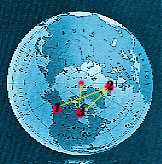 |
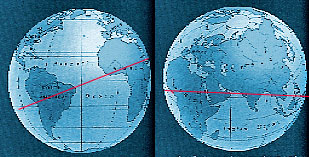
1.
Yukon |
|
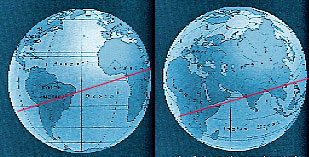
2.
Greenland Sea |
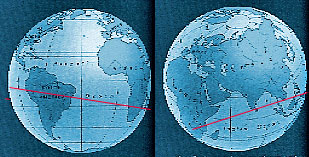
3.
Hudson Bay |
Interestingly, the Amazon jungle has
remained at the equator during each of these shifts, which may
account for its enormity.
James Bowles
James Bowles is a retired civil
engineer who worked for NASA sub-contractors on the Apollo moon
program.
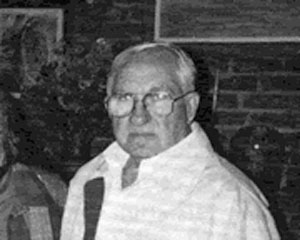
In his book The Gods, Gemini, and the Great Pyramid,
gives us a straightforward, easy to grasp theory on how the crust
can shift.
On the day of the pig roast
everything was ready.
The spit mechanism was in place, the pit
had been dug, there were all kinds of charcoal, and all the
guests were milling about. All we needed to start the
festivities was the pig and a match. So my dear wife, along with
Bonny, led us into the bathroom where the pig was laying covered
with ice in the bathtub. But one look at the pig and I knew we
were in trouble!
I'd figured on a fifty pound pig, because
that's what we'd talked about, but this had to be 100 pounds if
it was an ounce...
Well now that
one and a half inch of galvanized water pipe looked like a tooth
pick next to the pig, but it was too late to do anything about
it at this point, besides somebody had lit the charcoal.. Half
way through the night, the pipe broke, and the pig fell into the
fire.
Well to make a long story short, a friend of mine and I
went into town and got a bigger pipe from behind the garage and
put everything back together again.
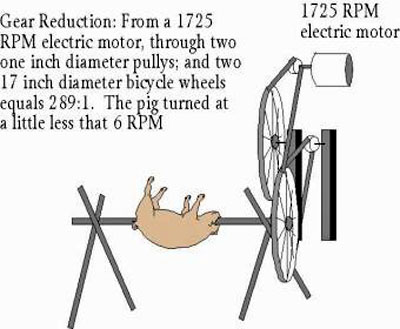
The point is that the pipe didn't just
break,
it broke from fatigue.
This is torque, forces created by
rotation.
Bowles calls it Rotational-Bending, or the RB-Effect. If
enough tension is happening within our planet, and it is constant,
then one day something must give, slip or break. Everything that
suffers stress will eventually crack. In our planet's case it would
be the semi-plastic attachment of the crust to the asthenosphere.
The stress would also create heat, and this could be a simple
explanation for volcanoes - an outlet valve for all the heat created
by the stresses within the earth. Bowles points out that an easy way
to break a piece of wire is to bend it backwards and forwards, over
and over, until it snaps. The ends of the broken wire will be quite
hot - heat being a by-product of stress.
Bowles uses the analogy of cargo on a
ship to further clarify his idea:
When cargo is tied securely, it
will ride with the ship and not come to any harm. But if the ropes
are loose, and the cargo slips and slides, then damage can occur.
The earth's crust is not securely tied;
rather it is connected to the core via a series of semi-plastic
layers, some of which are seas of molten rock and liquid iron.
The
waves in the cargo analogy correspond to the gravitational pulls of
the moon, sun and (to a much lesser extent) the other planets. Our
situation is that we have a crust that is 99.9% securely tied to the
planet's core. The sun and moon are constantly tugging away, testing
the attachment.
Eventually something has to give.
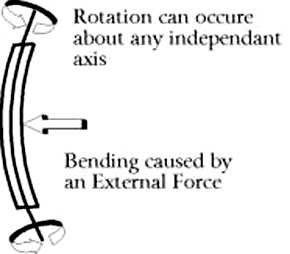
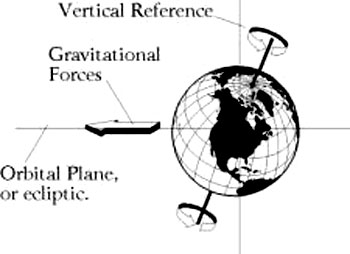
The centrifugal forces try to shift
matter towards the equator.
This is where the stress is. We talk
about a pole shift, but technically it's the entire crust that
shifts, around two fulcrum points, due to stresses towards the
equator. I came across a science Q&A website run by NASA, and found
questions regarding the number of earthquakes in Antarctica.
Here
are the expert's answers:
Antarctica is unusual in that there
are very few earthquakes there. Of all the seven or nine
continents, or of all the 7 or 25 plates (depending on how you
count), it has the fewest earthquakes, and it has none of the
big, damaging kind.
There are very few earthquakes in Antarctica.
It is one of the questions we are trying to answer out there.
There are numbers of plate boundaries and we have always been
astonished that we haven't seen more earthquakes.
We have wanted
to see them, we have tried to record them, but Antarctica is a
real puzzle because there are very few earthquakes. There should
be many more considering the type of plate boundaries there are,
and the type of continental structures there are, but there
aren't that many.
We are trying to work it out. But now it is
still a puzzle.
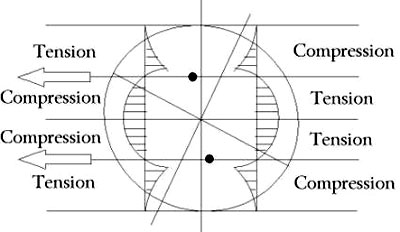
The polar
regions of this globe are unaffected by the forces at work,
hence very few earthquakes.
It is a puzzle if the standard
continental drift model remains in use.
The R-B Effect theory of
Bowles declares that the closer to the equator you get, the more
earthquakes there are, due to the forces of tension and compression.
When I went to high school, I was shown
a trick that fascinated me. Firstly, you wedge a ballpoint pen into
your desk somehow. Then you get the spring from inside a broken pen,
and you stretch it out. Using this wire like a two person wood saw,
you cut through the bottom of the pen's clip, and saw right through
to the top of the pen. It has to be done fast.
This action cuts the
plastic, but friction creates heat and causes the plastic to melt
together again, just behind the cutting action.
The result is a pen
with a surgical scar where the clip joins. I figure this is what
happens to the earth when the crust slips - it breaks away, and then
cements itself in place again.
In recent times
orthodox scientists are re-assessing our planet's internal
mechanics, and have finally started to accept pole shifts as a
possibility:
-
July
1996: Scientists at
Columbia University in New York confirmed that the earth's inner core
was spinning faster
than the planet itself, by approximately
1/3 of a second per day, allowing it to lap the Earth's
surface approximately once every 400 years. This may help explain
Earth's magnetic fields, and why they periodically reverse.
-
1997:
Researchers at the California Institute of Technology reported that
an evolutionary big bang, with relative evolutionary rates of more
than 20 times normal, coincided with another apparently unique event
in earth history; a 90-degree change in the direction of Earth's
spin axis relative to the continents.
The poleshift began
about 530 million years ago, taking roughly 15 million years to
complete. [Throughout this book I ask that you ignore these large
time periods, and allow that current dating techniques might, for
some reason, be fallible.]
As slow as this
sounds, normal continental drift cannot account for movement at such
a speed.
Dr. Joseph Kirschvink, a geologist and lead author of the
study, speculates that it was due to:
"true polar wander" which is caused
by "an imbalance in the mass distribution of the planet itself,
which the laws of physics force to equalize in comparatively
rapid time scales.
During this redistribution, the entire solid
part of the planet moves together, avoiding the internal
shearing effects which impose the speed limit on conventional
plate motions."
[12]
The study speculates
that changing weather patterns broke up ecosystems into smaller,
isolated communities, thus promoting rapid evolution.
The study also
implies that poleshifts and evolution have occurred in unison,
although a different reason for this will be explained in Chapter XX
-
January 2000:
Professor Sagar of Texas A&M University and Anthony Koppers of the
Scripps Institute of Oceanography have, while studying underwater
volcanoes, found evidence of poles shifting, albeit 84 million years
ago.
The shift consisted of "rapid latitude changes in various
locales", with rapid meaning a relatively rapid period of two
million years.
"We calculate that the sites of
Washington D.C. and Dakar, Senegal would have shifted south by 15 to
20 degrees".
The article is
highly technical but it appears they locate a previous pole at 58.9°N,
337.4°E
[13]
How long will it be
before a poleshift of 10,000 years ago is validated by scientists?
References
[9] Note: there have been numerous studies undertaken and as
many show that the Antarctic ice cap is growing as those that
show it to be melting.
[11] Hapgood stated that as hard as it was to find evidence
for the Hudson Bay location, the difficulties in locating the
previous poles were much greater. Earth's Shifting Crust,
page 275
[11a] James Bowles,
The Gods, Gemini, and the Great Pyramid, Gemini Books,
1998, pages 33-34
[12]
Science, July 25, 1997
- Evidence for a Large-Scale Reorganization of Early Cambrian
Continental Masses by Inertial Interchange True Polar Wander by
Joseph L. Kirschvink, Robert L. Ripperdan, and David A. Evans
[13]
Science,
Jan 21, 2000, p455-459
Evidence of...
A Recent Pole Shift
Part 1
Regardless of what caused the shift,
the poles would be relocated and climates everywhere would change
dramatically.
Lands of ice would melt and cause
incredible floods. The new poles would freeze over, with the intense
cold instantly killing life. Deserts would gain moisture;
rainforests would dry up. Flora and fauna would need to adapt to the
new conditions or become extinct.
If all the regions of our planet
previously had different climates, and the transition had been
violent, then we would expect some evidence to have been found.
Here
is a brief sample:
Frozen Muck
In Alaska thick frozen deposits of
soil, boulder, plant and animal exist, commonly known as "muck".
Prof. Frank C. Hibben of the University of New Mexico described
these deposits:
"In many places, Alaskan muck is
packed with animal bones and debris in trainload lots. Bones of
mammoths, mastodons, several kind of bison, horses, wolves,
bears and lions tell a story of a faunal population.
Within this
frozen mass lie the twisted parts of animals and trees
intermingled with lenses of ice and layers of peat and mosses.
It looks as though in the midst of some cataclysmic catastrophe
of ten thousand years ago the whole Alaskan world of living
animals and plants was suddenly frozen in mid-motion like a grim charade.
Twisted and torn trees are piled in splintered masses
at least four considerable layers of volcanic ash may be traced
in these deposits, although they are extremely warped and
distorted"[14]
This
suggests that although volcanoes were erupting, other forces were
required to dismember these animals - with mighty floods and
hurricanes being the most likely.
Rancho La Brea tar pits
These pits in the heart of Los Angeles
are one of the richest sources of fossils discovered to date. More
than 565 species all somehow got stuck in the tar (asphalt to be
precise) over tens of thousands of years, fossilising all the time.
Well, that's what the experts at the
George C. Page Museum would have us believe, but they fail to
explain the incredible density of animals that "got stuck" there.
During the first University of California excavations in 1906, they
found a "bed of bones" which contained over seven hundred sabre-toothed
tiger skulls.
These combined with wolf skulls averaged twenty per
cubic yard.[15]
Almost more bones than tar. They are
not the bones of animals that merely got stuck and waited to die.
They are "broken, mashed, contorted and mixed in a most
heterogeneous mass"[16],
just like in the muck of Alaska. And we mustn't overlook the
fossilised birds that have been dug up, 100,000 of them, including
over 138 species, 19 of which are extinct.
The George C. Page Museum
suggests that the 3,000 birds that are predators and scavengers may
have been attempting to feed on other trapped animals, when they
themselves got stuck. As sensible as this idea sounds, it fails to
explain the presence of the further 97,000 birds that were
non-carnivorous. Or three species of fish!
At the end of the last ice age (circa
10,000 BC) many North American species became extinct, including:
mammoths, camels, Pre-Columbian horses, ground sloths, peccaries,
antelopes, elephants, rhinoceroses, giant armadillos, tapirs, sabre-toothed
tigers and giant bison. All of these animals are relatively large.
Did they all become trapped in pits of asphalt? Was it the warmer
weather that killed them? If so, could they not have shifted
north?
Or were they wiped out by a terrible
catastrophe?
Frozen Mammoths
"Fossil bones are astonishingly
abundant in frozen ground of Alaska, but articulated
[*] bones are scarce, and complete skeletons, except for
rodents that died in their burrows, are almost unknown.
The
dispersal of the bones is as striking as their abundance and
indicates general destruction of soft parts prior to burial."[17]
Meanwhile in Siberia, mammoths were
being wiped out in a similar manner.
Massive graveyards of their
remains have been mined for ivory tusks. It has been estimated that
more than half a million tons of mammoth tusks were buried along
Siberia's Arctic coastline
[18], which equates to roughly five million mammoths.
Several dozen frozen mammoth carcasses have been found with the
flesh still intact.
They died suddenly. In their stomachs can be
found undigested vegetation, including grass, bluebells, wild beans
and buttercups
[19] - food typically available in the summer.
Scientists
examining them have concluded that three of the mammoths died of
asphyxiation. The cause of death of the others has not been
determined.
Regardless of cause, they froze within
days of dying, and when unfrozen the flesh has been fresh enough to
feed to dogs. With the previous pole positioned at Hudson Bay (see
below), the North Siberian coastline would have had the same
latitude as Japan does today, well outside of the Arctic Circle. But
when the poles shifted, the climate would have rapidly changed, from
a summer savannah where mammoths munched on buttercups, to a frozen
wasteland.
But wait a minute; weren't the woolly mammoths suited to living in a cold climate? They are
described as woolly due to their hairy coat, but this is only hair,
greaseless hair. To help protect them from the cold, all of
today's Arctic mammals have glands that make their hair oily to
retain warmth - the mammoths had no such gland.
Although thicker, a
mammoth's hair is the same as that of elephants, and they live in
the tropical regions. Many animals found in equatorial jungles also
have thick hair, the tiger being one such example.
Anyone still
unconvinced could consider this - bones of tigers, rhinoceroses and
antelope were found alongside the mammoths, and these are obviously
not Arctic creatures.
Bone Caves
"The great problem for geological
theories to explain is that amazing phenomenon, the mingling of the
remains of animals of different species and climates, discovered in
exhaustless quantities in the interior parts of the earth so that
the exuviae of those genera which no longer exist at all, are found
confusedly mixed together in the soils of the most northerly
latitudes...
The bones of those animals which can live only in
the torrid zone are buried in the frozen soil of the polar regions." [20]
All around the globe there are caves
which are full of bones.
Many of these contain the remains of
animals that would not have normally existed alongside each other.
One such cave, at Oreston, near Plymouth, England contained
mammoths, rhinoceroses, bears, lions and reindeer. Kent's cave in
nearby Torquay yielded, amongst another things, the bones of sabre-toothed
tigers.
A cave near Settle, in West Yorkshire,
contains the remains of the hippo, rhino, mammoth, bison, hyena and
other animals. They are buried under twelve feet of clay deposits
and the cave is 1450 feet above sea level.
Charles Lyell speculated
that:
"The hippopotami issued from North
African rivers, such as the Nile, and swam northward in summer
along the coasts of the Mediterranean, or even occasionally
visited islands near the shore.
Here and there they may have
landed to graze or browse, tarrying awhile, and afterwards
continuing their course northward... to the Somme, Thames or
Severn, making timely retreat to the south before the snow and
ice set in." [21]
Yet, according to his Theory of
Uniformity we should be able to observe hippos doing the same thing
today!
So, what could have caused hippo bones to be found deep
inside English caves? They may indeed have lived in England, but
hippos are not known to climb mountains by choice. They could have
been hiding from the cataclysm, sharing the cave with terrified
hyenas and bison.
Or their bodies, dismembered by a violent
cataclysm, may have washed up there, as part of a concurrent great
flood. It is reasonable to say that these two ideas are more sound
than hippos going on a summer holiday!
In China, near the village of
Choukoutien, among the animals found in caves were a porcupine,
tiger, woolly rhinoceros, camel, elephant, baboon, ostrich and a
species of tortoise. They are not of the same habitat - the bones
have been somehow gathered up and dumped in the caves.[22]
What forces of nature could do such a thing?
In Sicilian caves were found
hippopotami, hyenas, lions, Megatherium, rabbits, bears and
elephants.[23]
On Kotelnoi Island, in the Arctic Circle above Siberia, where
"neither shrubs, nor trees, nor bushes exist", are found the bones
of elephants, buffaloes, horses and rhinoceroses.[24]
Similar evidence is available worldwide - proof of destruction at
levels we dare not imagine to be possible.
Arctic Coral and Water
Lilies
Spitsbergen (now known as Svalbard) is
an island in the Arctic Ocean, just eleven degrees from the North
Pole, to the north of Norway.
It was uninhabited until the 1890s
when a mining colony was established there. For almost six months of
winter there is no sunlight, yet fossilized plants have been found
there, including pines, firs, elms, swamp-cypress and water lilies.[25]
[26]
Regardless of climate change, these cannot grow
anywhere without regular sunlight.
At some time in the past,
Spitsbergen must have been further away from the pole. Further
evidence comes from Soviet archaeologists who have discovered
prehistoric cave drawings of deer and whales, as well as axes
fashioned from mammoth tusks.
Reef corals have been found deep within
the Arctic Circle, on the islands of Ellesmere (Canada) and
Spitsbergen. Under snow now, they must have originally grown in a
tropical region.[27]
Coral requires a minimum temperature of 64° Fahrenheit to grow,
which means either a tropical location, or somewhere outside the
tropics where warm currents bring tropical waters into higher
latitudes (Japan, South Africa, and Bermuda for example).[28]
At the opposite pole, Antarctica,
Ernest Shackleton found coal beds within 200 miles of the South
Pole. The Byrd expedition of 1935 uncovered fossils that were later
identified as tree ferns, as well as the footprint of a "mammallike
reptile".[29]
At both ends of the globe, places which are currently the coldest on
earth, we find evidence of warmth equivalent to that of latitudes at
least 30 degrees closer to the equator.
The Weight of Ice
There is a lot of ice in the polar
regions. Antarctica has ice kilometers deep.
The weight of this ice,
estimated at nineteen quadrillion[30]
tons, will surely be compacting the land below, sinking it lower
than before the ice existed. If this mass of ice were to have
occurred anywhere else on land, a depression would result.
Take a
look at a map of the world and see if you can spot an area that may
have sunk - a circular area, crushed down to sea level or lower. I
found two that immediately stood out - Hudson Bay and the Gulf of
Mexico.
Hudson Bay in
NorthEast Canada is a large inland sea covering 730,380 sq
km, yet has a rather shallow average depth of just 130 meters. It
was the epicenter of the North American ice sheet during the last
Ice Age, which extended as far south as Ohio. North West of Hudson
Bay the subsoil is permanently frozen.
Halfway between this region
and the current North Pole is Greenland, the interior of which is
covered in ice all year long. This is to be expected if it was
within the previous polar circle as well as the current one - it
never had a chance to melt.
Hudson Bay is roughly 30 degrees south
of the North Pole, and the Gulf of Mexico a similar distance south
again.
These spots would fit a model of regular uni-directional
shifts. If the shift had a more random nature then other previous
polar locations could include a large depression in Africa called
the Sudan Basin. It is littered with waterways, which have no
apparent connection to each other, nor with the ocean.
It contains
Lake Chad, which originally covered 300,000 square kilometers, but
is now less than one thirtieth of that size and is still shrinking.
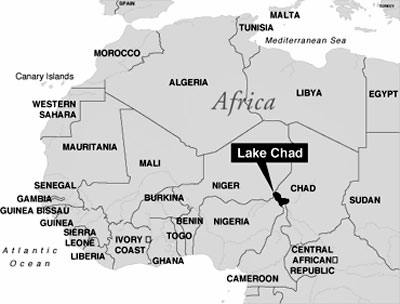
The first two locations just noted are
diametrically opposite regions of the Southern Ocean, areas where
similar depressions in land cannot occur.
Opposite Lake Chad is the
South West Pacific, again devoid of major land masses.
Recent Extinction of
Large Quadrupeds
"True extinction (end of a phyletic
lineage without phyletic replacement) has occurred throughout
the history of life on earth.
Among the terrestrial vertebrates,
the fossil evidence suggests two striking episodes of
extinction: one at the Mesozoic-tertiary transition saw the
extinction of the last dinosaurs, the other at the
Pleistocene-recent transition saw the sudden dramatic
disappearance of large mammals in most but not all parts of the
world."[31]
"We live in a zoologically
impoverished world from which all the hugest, and fiercest, and
strangest forms have recently disappeared.
Yet it is surely a marvelous fact, and one that has been sufficiently dwelt upon,
this sudden dying out of so many large Mammalia, not in one
place only but over half the land surface of the globe."[32]
In North America an estimated 40
million animals died at the end of the last ice age (12,000 years
ago).
Many of the mammals became extinct, especially the larger
ones. The Americas were home to a range of very large mammals, such
as the Megatherium (5.5 metre ground sloth), Glyptodon
(4 metre giant armadillo), mammoths, sabre-toothed tigers and
horses.
Gradualists, who accept that climate
change could not have been the sole cause, are puzzled as to how
these extinctions happened. For example, we know that post-Columbian
horses thrive today in the same areas where fossils of their extinct
cousins are found.
The problem is made more difficult when we look
at southern Africa, which contains many similar climatic zones, yet
lacks the recent extinction of large mammals - large mammals that
are obviously less agile than other species, less suited to sudden
disasters.
The Smilodon (sabre-toothed tiger) for example,
while being smaller in size than the African lion, was twice as
heavy[33].
Imagine if a concrete apartment building had a variety of animal
species as tenants, and, as we often see on television, it was
detonated.
Which species could possibly survive? Giraffes?
Sloths? Humans? Or smaller beings like a rat, ant or cockroach. Or
in the case of a flood, which animals are unable to scale steep
slopes and escape the rising waters?
The poor Megatherium (which
weighed 3-4 tons) would not have had a chance.
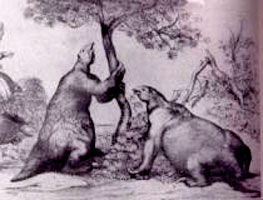

Grab a globe and find the southern
coast of Nigeria. On the opposite side is Kiribati in the Pacific
Ocean.
If the North Pole's previous position
was at Hudson Bay, then these two places are roughly the fulcrum
points of the last pole shift. Place a finger at each position and
see how you can swivel the North Pole to where Hudson Bay is today.
This "line of most movement" continues down through the United
States and along the west coast of South America, across Antarctica,
the Indian Ocean, South-East Asia, China and Siberia. All points
along this line would have shifted 30 degrees in latitude. The two
fulcrum points are the only two spots on the globe that didn't
change latitude.
The closer to the fulcrum, the less the change.
Closer to the "line of most movement" equals more change.
The extinctions of 10,000 years ago
mostly occurred along the "line of most movement", along with major
geology upheavals, such as the rising of the Andes mountain range.
I
suggest that during global cataclysms, at locations along the "line
of most movement", there is a correlation between the size of
animals and their extinction.
References
[*] The "articulation" of bones means an arrangement of
bones that a person observing them would identify as a
complete skeleton, and from which an experienced observer
could identify the species. For articulated bones to be
scarce, means that the bones are mixed and scattered so
badly that a lot of expert attention would be required to
identify even the species.
[14] F. V. Hibben, "Evidence of Early Man in
Alaska", American Antiquity, VIII (1943) p254-259
[15] Immanuel Velikovsky, Earth in Upheaval
(1955), p59
[16] G. M. Price, The New Geology (1923),
p579
[17] Stephen Taber, "Perennially frozen ground in
Alaska: Its Origin and History", Bulletin of the
Geographical Society of America 54 (1943), p. 1489
[18] John Massey Stewart, "Frozen Mammoths from
Siberia Bring the Ice Ages to Vivid Life," Smithsonian,
1977, p. 67.
[19] Ivan T. Sanderson, "Riddle of the Quick-Frozen
Giants", Saturday Evening Post, Jan 16 1960, p82
[20] Penn,
Granville, A Comparative Estimate of the Mineral
and Mosaical Geologies, Vol. II, 2nd ed.,
London, 1825, p. 81.
[21] Charles Lyell, Antiquity of Man (1863),
p180
[22] D. S. Allan & J. B. Delair, When the Earth
Nearly Died (1995), p114
[23] Fairholme,
George, New and Conclusive Physical
Demonstrations of the Fact and Period of the Mosaic
Deluge, n.p., 1837.
[24] D. Gath Whitley, Journal of the
Philosophical Society of Great Britain, XII (1910)
p50.
[25] O. Heer, Flora Artica Fossilis: Die fossile
Flora der Polarl¬nder
(1868).
[26] Charles H. Hapgood, The Path of the Pole,
(1999), Adventures Unlimited Press, page 67
[27] C. O. Dunbar, Historical Geology (1949),
pp 162, 194
[28] Coral Bleaching, Coral Mortality, and Global
Climate Change, Report presented by Rafe Pomerance,
Deputy Assistant Secretary of State for the Environment
and Development - To the U.S. Coral Reef Task Force, 5
March 1999, Maui, Hawaii, Released by the Bureau of
Oceans and International Environmental and Scientific
Affairs, U.S. Department of State, March 5, 1999,
http://www.state.gov/www/global/global_issues/coral_reefs/990305_coralreef_rpt.html
[29] Charles H. Hapgood, The Path of the Pole,
(1999), Adventures Unlimited Press, page 62
[30] Note: Quadrillion = 15 zeroes, ie
19,000,000,000,000,000 tons
[31] J.E. Guilday, Differential extinction during
Late-Pleistocene and recent times, in Pleistocene
Extinctions: The Search for a Cause, ed. P. Martin
and H.E. Wright (New Haven: Yale University Press,
1967), pp 75-120
[32] A.L. Wallace, The Geographical Distribution of
Animals, vol.1, (London: MacMillan, 1876) p 150
[33] Saber-toothed Tales,
Discover, Apr93, Vol.
14 Issue 4, p50
Part 2
Floods
The greatest flood to be accepted by
orthodox science may be the deluge of 14,000 years ago[†]
in the Altai Mountains of southern Siberia.
"It was an event that's very hard to
describe- because nothing comparable has ever been seen by people,"
says Victor Baker, a geologist at the University of Arizona. "It's
the largest flood we can document in the fossil record."
At its
height, he says, the water may have been 1,500 feet deep, racing
along the Chuja River valley at 90 miles an hour.
Baker had been working with Alexey
Rudoy, a Siberian geologist, who had argued for years that only
massive flooding could have formed the oddly rippled terrain and
giant bars of gravel found in the Chuja Valley and nearby regions -
not glaciers, as was commonly believed.
"Near the end of the last ice age,
they say, a glacier crawled out of a valley perpendicular to the
Chuja Valley and cut across the latter, effectively damming it
and creating a lake nearly 3,000 feet deep that held 200 cubic
miles of water.
Eventually that ice dam broke the lake either
burst through the dam or lifted the entire glacier. Water rushed
into the narrow river valley at the rate of 640 million cubic
feet per second, in a deluge that probably lasted several days."
The Chuja Valley flood was just the
largest of numerous ice-age inundations, says Baker. "Even the
English Channel has been attributed by some to late-glacial
catastrophic flood erosion," he says, "though it hasn't been
proven."[34]
Meanwhile in North America:
The Missoula Floods, 16,000-14,000 years
ago (Pleistocene)
Did you know that the largest
floods to occur on the planet happened here?
During the last ice
age, ice sheets covered much of Canada. One lobe of ice grew
southward, blocking the Clark Fork Valley in Idaho. This 2,000
foot (600 meters) high ice dam blocked the river, creating a
lake that stretched for hundreds of miles. When the lake was
full, it contained 600 cubic miles (2,500 cubic kilometers) of
water.
How much is that?
Imagine a block of water a mile
high (as high as the mountains around Bonneville Dam), a miles
wide, and stretching from Bonneville Dam to San Francisco!
Eventually, water traveled under
the ice dam. The water drained out of the lake in two or three
days,
flooding eastern Washington. The flood, moving up to sixty
miles per hour, scoured out hundreds of miles of canyons called
coulees, created the largest waterfall to ever exist, and left
300 foot (90 meter) high gravel bars.
At Bonneville, the water
crested at 650 feet (200 meters). If you look on the cliffs
southeast of the dam, you will see a transmission tower (the one
with three poles) that is 200 feet (60 meters) above the high
water mark.
During a period of 2,500 years as
many as 100 of these floods scoured the Gorge.
The source of this information is from
a page at a
U.S. Government website.
It details the (orthodox) geologic
history of the Columbia River Gorge. Like the Siberian flood,
scientists describe a glacier that blocks a valley and creates a
dam. However the trapped water does not freeze, it slowly builds up
then bursts through the barrier of ice. This is apparently the only
non-catastrophic, gradual situation they can think of!
Prior to the catastrophic floods,
albeit 12-40 million years prior, this district was also host to a
spectacular amount of volcanic activity. They state that 41,000
cubic miles (170,000 cubic kilometers) of lava spread to cover large
parts of Oregon and Washington. This is enough to cover the entire
continental USA with at least 12 meters of lava!!
Elsewhere
[35], sections of lava in the Columbia River area have
been estimated to be 3,500 meters thick!!
If we were to disregard the dating of
these events, then we have two obvious after-effects of a pole
shift, one occurring directly on top of the other.
Volcanoes
An event as catastrophic as a pole
shift would undoubtedly create an increase in volcanic activity.
In
fact, I suspect that every volcano along the “line of most movement”
would have exploded. Evidence of past lava flows indicate that our
current level of volcanic activity is very low, a mere whimper. In
my opinion, there has been a gradual decline of activity over the
last 10,000 years, as the earth’s crust has settled into its new
position, and the volcanoes have slowly died down.
A shift of the crust would require some
stretching and contracting due to the equatorial bulge. Any section
of the crust that moved into the area of the equator would have to
stretch to accommodate the bulge. On the other side of the equator,
where section of the crust were moving away, there would be
contraction.
Distortions of this magnitude would
give us the “fire” element so often part of the flood myths -
volcanoes.
"In Arizona, New Mexico and
southern California there are very fresh looking volcanic
formations. The lava flow in the valley of the San Jose River in
New Mexico is so fresh that it lends support to Indian
traditions of a “river of fire” in this locality."[36]
Ten thousand years ago, volcanoes were
active everywhere.
Listed here are the active areas of the southern
hemisphere:[37]
|
Nigeria
Kenya
Tanzania
Great Rift Valley
Madagascar
Indian Ocean
Burma |
Malaysia
Indonesia
New Hebrides
Bismarck Sea
New Guinea
New Zealand
Solander Islands |
Australia:
N Queensland
SE NSW
West Victoria
Tasmania |
Antarctica:
S. Ant. Peninsula
Ellsworth Land
Marie Byrd Land
The Andes (entire)
Brazil - Mato Grasso
Chile (800 volcanoes) |
The northern
hemisphere covers pretty much everywhere except Europe.
As we can see, Chile alone had more
active volcanoes back then, than the 500 the entire globe has today.
Volcanoes are so sensitive that we can assume the majority of them
would erupt during a pole shift situation.
Our atmosphere would be
filled with dust and the sun would effectively disappear from view
for a few years. An example of this is the eruption of Krakatoa in
1883 - this single volcano lowered the mean earth temperature by
about 1ºC for several years
[38], and many parts of the world lost an entire growing
season.
With hundreds of volcanoes erupting at once our planet would
be plunged into winter, with the new poles freezing over rapidly.
The amount of dust in the air, and
corresponding lack of sunlight caused by a pole shift is
unpredictable, but even a layman can guess that it would be many,
many times more severe than the explosion of Krakatoa.
A number of
doomsday researchers have pointed out how the dust would create a
tragic, incredibly cold period. However, the severity may well be
offset in part by the carbon dioxide that volcanoes produce. While
dust will stop the sun’s rays from entering our atmosphere,
carbon-dioxide will stop heat from escaping, the much discussed
“greenhouse effect”.
Carbon dioxide also stimulates plant growth,
but only when there is sunlight as well. The climate following a
pole shift is very difficult to predict.
Prepare for anything.
|
Volcanic Gases
All magmas contain dissolved
gases that are released during and between eruptive
episodes. These gases are predominately steam, followed
in abundance by carbon dioxide, compounds of sulfur and
chlorine,
and lesser amounts of other gases.
While they
rarely reach populated areas in lethal concentrations,
sulfur dioxide can travel downwind and react with the
atmosphere to form acid rain that causes corrosion and a
host of other problems.
Carbon dioxide is heavier than
air and tends to collect in depressions, such as
valleys, where it can occur in concentrations lethal
enough to
cause suffocation of people and animals.[39] |
Seashells
In my own travels, during a visit to
mountains in New Zealand, I pondered over why there should be
seashells high upon them.
Yes, New Zealand is a relatively new
country - supposedly it slowly rose from the ocean 26 million years
ago. But how are these shells, which easily break beneath my shoes,
which I could easily turn into sand, still in one piece after 26
millions of years?
Have they survived earthquakes and weather for
such a terribly long time? Or could the islands of New Zealand have
re-emerged from the ocean only 12,000 years ago? [40]
Graham
Hancock found a similar situation at Lake Titicaca, on the border of
Peru and Bolivia:
Though now more than two miles
above sea level, the area around Lake Titicaca is littered with
millions upon millions of fossilized sea shells. This suggests
that at some stage the whole of the Altiplano was forced upwards
from the sea-bed, perhaps as part of the general terrestrial
rising that formed South America as a whole… [41]
This would be in line with orthodox
scientists, who believe that this occurred very slowly 100 million
years ago.
But Hancock points out that many of the fish and crustacea in the lake are of a salt-water variety, as if they hadn’t
had time to evolve into fresh water types. Indeed this is the only
fresh water location on earth where seahorses live.
The ancient city of Tiahuanaco, is
currently 12 miles distant, and 100 feet higher than the lake. Yet,
this city has ruined docks, which implies that within the civilised
history this area was subject to a major upheaval.
It is frightening
to think that there are forces that can shift landscapes two miles
vertically, and this may have happened 12,000 years ago in South
America.
****
You may have noticed that we haven’t
discussed any internal forces that can make the poles shift - I
don’t think there are any. The RB-Effect of James Bowles relies on
the pull of the sun and the moon.
I believe the required forces must
come from farther away.
Extra-terrestrial forces are infinite
and mostly unknown. If something out there is capable of tilting the
Earth, we are yet to discover it. But there are a few clues. Global
cataclysms have occurred previously, and presumably will happen
again.
Any prediction of when must be based on calculable processes.
If
the Mayan calendar proves to be prophetic, then this cosmic
disturbance must be a regular and predictable occurrence, not a
random collision or interaction. If evolution is caused by cosmic
rays (see Chapter XX), then they must be a component of the
disturbance.
And if humanity manages to survive each cataclysm, the
disturbance’s effect must fall a little short of total annihilation.
References
On the Possibility of Very Rapid Shifts of the
Poles, by Flavio Barbiero - Technical
[34] Folger, Tim; The Biggest Flood, Discover,
15:36, January 1994.
[35] Volcano World, (sponsored by NASA) http://volcano.und.nodak.edu/vwdocs/volc_north_america/crb.html
[36] Jaggar, Thomas A., Volcanoes Declare War.
Honolulu, Paradise of the Pacific, (1945), page 113
[37] D. S. Allan & J. B. Delair, When the Earth
Nearly Died (1995), p261
[38] Rampino, M. R. and S. Self. Historic eruptions of
Tambora (1815), Krakatau (1883), and Agung (1963), their
stratospheric aerosols, and climatic impact. Quaternary
Research 18:127-143. (1982)
[39] http://wapi.isu.edu/EnvGeo/EG6_volcano/volcanoes.htm
[40] At 1,400 feet (400 meters) altitude in the Andes
Mountains of South America, there are high water surf marks
lined with undecayed seashells.
[41] Graham Hancock,
Fingerprints of The Gods, 1995, page 67
|















